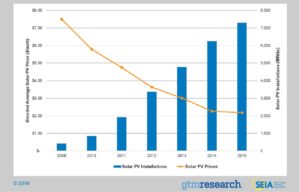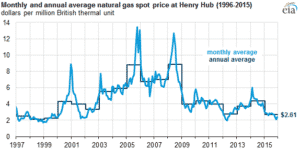Sometimes our clients ask if fluctuating prices in the fossil fuel industries have a bearing on the viability or adoption of solar energy. While the cost of one energy source compared to another would seem to have an impact from a big-picture point of view, the short answer is no. Falling natural gas prices, continued use of nuclear, coal, wind, and hydro-electric have not hampered the rapid growth of solar electric installations. Here are some charts for comparison:
Falling installation prices, as seen in the orange line are likely the largest contributor to the growth of solar electric, seen in the blue bars. See here for more fun charts: http://www.seia.org/research-resources/solar-industry-data
Natural gas prices have generally gone down over the same period, but it doesn’t seem to have an impact on the solar industry.
Rather than being in competition, there is an important way in which solar and natural gas complement each other. Solar is an intermittent resource, to some extent unpredictable, while natural gas plants can be turned on and off much easier than coal or nuclear plants. In this way, natural gas power plants can react to renewable energy resources by turning off when a significant amount of solar electricity is going to the power grid. Here’s an interesting related article: http://www.pri.org/stories/2015-03-29/natural-gas-and-solar-power-have-been-growing-together-can-last
In other ways, solar energy and fossil fuels are an “apples to oranges” comparison. Each source of energy has its specialty. For example, very few people use oil to power their homes, and very few people use electricity to power their cars. This perspective also applies to the various renewable energy resources, hydro-electric works well on the utility scale, but not so good for a single home unless you have your own mountain stream. Solar electric works great to supplement a homes energy mix, but needs an enormous system with a battery bank to fully power the home.
Solar electric still accounts for a tiny fraction of the USA energy mix, about 0.6%. https://www.eia.gov/tools/faqs/faq.cfm?id=427&t=3 Still, every year breaks new records for the number of solar installations.
When considering the options for power generation, it’s not a matter of which works best, but what is the best source of energy for each unique energy requirement.


